Art
Advertising
- Advertising
- Tin (Cassiterite) Distribution: Mediterranean Bronze Age
- Archaeological Sites of the Aegean Minoans
- Extent of Santorini Eruption's Tsunami Inundation of Minoan Crete
- End of Minoan Linear A Writing and LM IB Fire Destruction of Crete
-
The Cause of the End of the Bronze Age
with the Scientific Method -
Nature Geoscience Journal and
Late Minoan IB Destruction Event - Prehistoric Star Navigation, Eastern Mediterranean Ethnocentric Bias, and the "Cabal of Certainty"
- Theoretical Bronze Age Minoan Heliographic Aegean Network Validated by 92.15 Mile (148.3 Km) Mirror Sunlight Flashes
- The Validation of a Bronze Age Minoan Heliographic Aegean Network in Southern California
- Tsunami Generation from the Titanic Bronze Age Minoan Eruption of the Santorini Marine Volcano
- The Cento Camerelle Mines of Tuscany: A Major Bronze Age Source of Tin
- No Men or Sails Required: Successful Prehistoric Sea Travel
- Minoan Downfall and Volcanology's Black Hole of Unknowns
- Homer and Navigating by the Stars in Prehistory
- Primacy of Human Powered Rowing in Copper Age and Minoan Shipping
- Minoan Invention of the True Dome and Arch Prehistoric Mediterranean Catenary Architecture
- "Sinking Atlantis" Tsunami Myth Debunked
- Minoan Tholos Structural Mechanics and the Garlo Well Temple
- Minoan Web of Mirrors and Scripts
- Santorini Eruption and LM IB Destruction
- Minoan Catastrophe: Pyroclastic Surge Theory
- Early Minoan Colonization of Spain
- Origin of the Sea Peoples
- Minoan Ship Construction
- Minoan Maritime Navigation
- Ringed Islands of Thera, Santorini, Greece
- Minoan Scientific Tradition
GIS Google Earth
Publications
Publications
Official Art Gallery
A Collection of 20 Paintings each with over 70 Art Products
The author discusses the possibility that a pyroclastic surge(s) of superheated dry steam traveled at very high speed over 110 kilometers of sea water to incinerate large areas of the island of Crete during the Bronze Age eruption of the Santorini volcano.


Minoan Miniature Frieze Admirals Flotilla Fresco
in Three Panels
Late Bronze Age (LBA)
Neo-Palatial Late Minoan I Period
The West House, Room 5, South Wall
3.90 x 0.43 meters
Akrotiri, Santorini (Thera), Greece.
in Three Panels
Late Bronze Age (LBA)
Neo-Palatial Late Minoan I Period
The West House, Room 5, South Wall
3.90 x 0.43 meters
Akrotiri, Santorini (Thera), Greece.
Science has long believed that the Minoan Santorini eruption was similar in scale to the Krakatau eruption of 1883 in Indonesia. More recent measurements of Santorini's eruption deposits indicate that it was actually closer to ten times bigger than Krakatau with a VEI (Volcanic Explosivity Index) of seven. This makes Santorini one of the largest volcanic eruptions in the last 20,000 years. Only Tambora in 1815 and a few other eruptions were bigger.
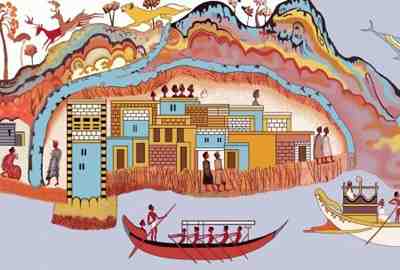
Minoan Depiction of the Ringed Islands of Thera
Minoan Miniature Frieze Admirals Flotilla Restoration Fresco
Late Bronze Age (LBA)
Neo-Palatial Late Minoan I Period
West House, Room 5, South Wall
Akrotiri, Santorini, Greece
Minoan Miniature Frieze Admirals Flotilla Restoration Fresco
Late Bronze Age (LBA)
Neo-Palatial Late Minoan I Period
West House, Room 5, South Wall
Akrotiri, Santorini, Greece
Unlike Tambora, Krakatau and Santorini are marine volcanoes with magma chambers very close to sea level. It is well attested that Krakatau produced a pyroclastic surge containing super-heated steam that traveled over water for 40 kilometers and then rose several hundred meters up the side of Mt. Rajabasa, a 1,284 meter high inactive volcano in southern Sumatra, to burn nearly 2,000 people to their deaths. Johanna Beyerinck, the wife of a Dutch official in Ketimbang, Sumatra was a severely burned eyewitness that narrowly escaped death to give her account. The American trading vessel W. H. Besse was over 80 kilometers from Krakatau when it was blasted by hurricane winds carrying sand and ash, but the bloom's lethal heat had cooled and the crew survived.
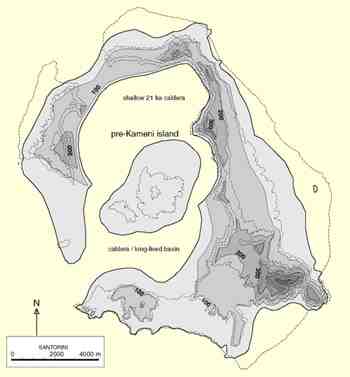
Geological Reconstruction of Pre-Eruption Minoan Thera
Druitt and Francaviglia, 1992
Santorini (Thera), Greece
Courtesy: Tom Pfeiffer
Druitt and Francaviglia, 1992
Santorini (Thera), Greece
Courtesy: Tom Pfeiffer
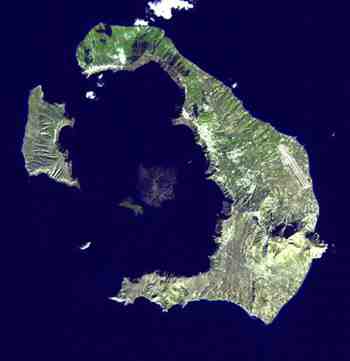
Present Day Landsat Image of Thera
Santorini (Thera), Greece.
Santorini (Thera), Greece.
In 1902 the Mount Pelee volcano on Martinique in the Caribbean generated a surge that was calculated to have an initial velocity of over 670 kilometers per hour with a temperature exceeding 1,000°C and killed about 30,000 people. It continued out over open water to capsize and burn ships several kilometers away. Mount Pelee had a VEI of four making it approximately 1,000 times smaller than Santorini. The phenomenon of the pyroclastic surge is well documented in modern times.
The Santorini volcano is part of the Hellenic Volcanic Arc which is caused by the convergence of the African and Eurasian tectonic plates. The Arc is fed magma and dissolved gas (mainly steam - H2O) created by the fractional melting of the African plate as it subducts into the earth's mantle underneath the Eurasian plate's Aegean subplate. The rate of subduction is about five centimeters per year. Great quantities of water are transported into the mantle during this process.
The Santorini volcano is part of the Hellenic Volcanic Arc which is caused by the convergence of the African and Eurasian tectonic plates. The Arc is fed magma and dissolved gas (mainly steam - H2O) created by the fractional melting of the African plate as it subducts into the earth's mantle underneath the Eurasian plate's Aegean subplate. The rate of subduction is about five centimeters per year. Great quantities of water are transported into the mantle during this process.

Mount Pinatubo Volcanic Eruption
Volcanic Explosivity Index (VEI) - 6
Zambales Mountains, Luzon, Phillipines
1991
Volcanic Explosivity Index (VEI) - 6
Zambales Mountains, Luzon, Phillipines
1991
The primary gas ejected during eruptions from volcanoes associated with convergent plates is superheated dry steam. If an erupting volcano's magma chamber is well above sea level, the steam ejected will involve only the water dissolved in the magma and any nearby ground water that is heated by it. This limits the volcano's ability to generate large steam surges. If the magma chamber is submerged in water and well below sea level, the exposure of the magma to sea water is maximized, but the heat and force of the steam generated is quickly dissipated in the much heavier and colder sea water around it.

White Island Marine Volcano
Bay of Plenty, North Island, New Zealand
Bay of Plenty, North Island, New Zealand
Youtube Netflix Trailer
White Island (Whakaari Island)
Marine Volcanic Eruption
Bay of Plenty, North Island, New Zealand
White Island (Whakaari Island)
Marine Volcanic Eruption
Bay of Plenty, North Island, New Zealand
In the relatively rare case of a marine volcano (Santorini, Krakatau, etc.) whose magma chamber is at or near sea level, the magma-water exposure is maximized, but the resulting explosions of superheated dry steam are able to enter the atmosphere to scorch everything they touch. The probability of immense high-speed lateral blasts of turbulent hot gas blooms racing over the surface of the surrounding water is greatly increased. Marine volcanoes at sea level are an extreme hazard to all life within reach of their burning pyroclastic surges. Their ability to slide almost frictionlessly at very high velocities over water is probably much greater than what, so far, has been observed or deduced in modern times especially when they are associated with truly colossal eruptions like Minoan Santorini.
Depending on a number of factors, superheated steam can explode from a volcano's magma chamber like the popping of a shaken soda can's top. The initial velocity of the gas is proportional to its containment pressure at the time of its jetted release through the explosive opening of one or more vents. I see no reason why the initial velocity of an ejected gas bloom cannot exceed the speed of sound - 344 meters/second (1,238 km/hour). The gas velocity of the Plinian phase of the eruption has been estimated at 550 meters/second (1,980 km/hour) (Bond, Sparks 1976). A high-speed pyroclastic gas bloom can travel for a great distance before its killing heat finally dissipates in the atmosphere.
Depending on a number of factors, superheated steam can explode from a volcano's magma chamber like the popping of a shaken soda can's top. The initial velocity of the gas is proportional to its containment pressure at the time of its jetted release through the explosive opening of one or more vents. I see no reason why the initial velocity of an ejected gas bloom cannot exceed the speed of sound - 344 meters/second (1,238 km/hour). The gas velocity of the Plinian phase of the eruption has been estimated at 550 meters/second (1,980 km/hour) (Bond, Sparks 1976). A high-speed pyroclastic gas bloom can travel for a great distance before its killing heat finally dissipates in the atmosphere.
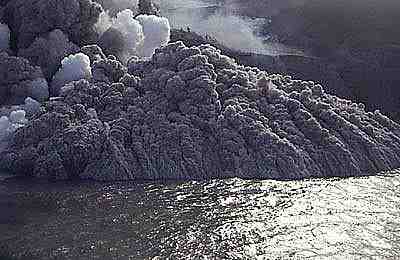
Volcanic Pyroclastic Surge flowing over the Sea
Montserrat, Lesser Antilles, Caribbean
1996
Montserrat, Lesser Antilles, Caribbean
1996
The highly turbulent low-density mixture of superheated dry steam and suspended rock debris with smaller amounts of other gases (carbon dioxide - C02, sulfur dioxide - S02, hydrogen chloride - HCL, etc.) is heavier than the surrounding air and will settle into a layer between the surface of the water and the air above it. Its low-density allows the surge to quickly spread over large areas and easily rise up and crest high topographical features.
Steam occupies a volume that is about 1,600 times the volume of the water that produced it. There were probably many steam surges generated during the Santorini eruption, but an estimate of the minimum size required for a single pyroclastic gas bloom originating from Santorini to completely envelope central and eastern Crete is on the order of 10,000 square kilometers. Assuming an average height of 500 meters for the bloom layer to estimate it's volume, it would have required only 3.1 cubic kilometers of water (5,000 cubic kilometers of steam) to produce it. It is possible that Santorini's magma chamber could have exposed more than 30 cubic kilometers of sea water to the molten rock inside it generating over 48,000 cubic kilometers of steam. Given the tremendous scale of the Santorini eruption, it is possible that it could have jetted multiple long-runout pyroclastic steam surges over water to incinerate large areas of Crete and many other islands in the Aegean.
Steam occupies a volume that is about 1,600 times the volume of the water that produced it. There were probably many steam surges generated during the Santorini eruption, but an estimate of the minimum size required for a single pyroclastic gas bloom originating from Santorini to completely envelope central and eastern Crete is on the order of 10,000 square kilometers. Assuming an average height of 500 meters for the bloom layer to estimate it's volume, it would have required only 3.1 cubic kilometers of water (5,000 cubic kilometers of steam) to produce it. It is possible that Santorini's magma chamber could have exposed more than 30 cubic kilometers of sea water to the molten rock inside it generating over 48,000 cubic kilometers of steam. Given the tremendous scale of the Santorini eruption, it is possible that it could have jetted multiple long-runout pyroclastic steam surges over water to incinerate large areas of Crete and many other islands in the Aegean.
The Neo-Palatial Minoan Destruction Event
The destruction of Neo-Palatial Minoan Crete has never been definitively explained by science. The evidence indicates that only a thin layer of volcanic ash fell on Crete during the entire eruption sequence. This was probably from a precursory eruption associated with a north wind that preceded the main sequence by some months. Ash from the huge main eruption was blown generally to the east; away from Crete. This was likely due to a west wind in late spring or early summer. The dusting of the crops and plants on Crete would have been cleaned by the wind and rain. The damage from ash fall would have been slight.
The current scientific consensus for the Minoan catastrophe is that huge tsunamis generated by the Bronze Age eruption enveloped Crete and destroyed much of its economy and population. There must have been tsunamis similar to the 35 to 40 meter high waves of Krakatau and they were very likely larger and more devastating. But, even if the biggest of the Theran tsunamis was over 150 meters tall, most of its worse effects would have been felt on the low-lying coastal plains of the north coast only. Crete's northern coastline would have acted like a 250 kilometer long breakwater that absorbed and reflected much of the tsunami's energy back into the Aegean. This would have significantly reduced the amount of wave energy able to escape into the open waters of the Mediterranean Sea. The damage to Crete's southern coast from a tsunami wrap-around effect would have been minimized.
The vulnerable northern coastal areas of Crete would have been inundated and completely destroyed. The complex at Mallia, about 30 kilometers to the east of Knossos, was scraped almost to its foundation by the tsunamis, but it was only 600 meters from the sea at an elevation of 11 meters. The tsunami would have merely washed up on the nearby 400 to 700 meter high foothills three or four kilometers to the south before it receded back into the sea. No volcanic tsunami could ever have washed completely over mountainous Crete. The large populations of Arkhanes and Phaistos to the south would have been essentially unaffected. The palace complex of Knossos was over five kilometers inland at an elevation of 90 meters and was not scraped clean by a tsunami. It was burned!
Modern evidence shows that populations in areas destroyed by tsunamis and earthquakes recover relatively quickly. Several decades earlier, the Minoans recovered vigorously from a major earthquake event to rebuild their palaces to their greatest extent. The palace at Knossos was repaired and continued to function in some capacity after the catastrophe. But, it was the only palace to be rebuilt. None of the other palaces ever recovered. Apparently, the palace at Phaistos in southern Crete was incinerated by a fierce fire and abandoned forever. The theory of a pyroclastic steam surge(s) scorching and blanketing large areas of Crete in fire during the Minoan eruption is a good fit for the otherwise puzzling archeological evidence.
The current scientific consensus for the Minoan catastrophe is that huge tsunamis generated by the Bronze Age eruption enveloped Crete and destroyed much of its economy and population. There must have been tsunamis similar to the 35 to 40 meter high waves of Krakatau and they were very likely larger and more devastating. But, even if the biggest of the Theran tsunamis was over 150 meters tall, most of its worse effects would have been felt on the low-lying coastal plains of the north coast only. Crete's northern coastline would have acted like a 250 kilometer long breakwater that absorbed and reflected much of the tsunami's energy back into the Aegean. This would have significantly reduced the amount of wave energy able to escape into the open waters of the Mediterranean Sea. The damage to Crete's southern coast from a tsunami wrap-around effect would have been minimized.
The vulnerable northern coastal areas of Crete would have been inundated and completely destroyed. The complex at Mallia, about 30 kilometers to the east of Knossos, was scraped almost to its foundation by the tsunamis, but it was only 600 meters from the sea at an elevation of 11 meters. The tsunami would have merely washed up on the nearby 400 to 700 meter high foothills three or four kilometers to the south before it receded back into the sea. No volcanic tsunami could ever have washed completely over mountainous Crete. The large populations of Arkhanes and Phaistos to the south would have been essentially unaffected. The palace complex of Knossos was over five kilometers inland at an elevation of 90 meters and was not scraped clean by a tsunami. It was burned!
Modern evidence shows that populations in areas destroyed by tsunamis and earthquakes recover relatively quickly. Several decades earlier, the Minoans recovered vigorously from a major earthquake event to rebuild their palaces to their greatest extent. The palace at Knossos was repaired and continued to function in some capacity after the catastrophe. But, it was the only palace to be rebuilt. None of the other palaces ever recovered. Apparently, the palace at Phaistos in southern Crete was incinerated by a fierce fire and abandoned forever. The theory of a pyroclastic steam surge(s) scorching and blanketing large areas of Crete in fire during the Minoan eruption is a good fit for the otherwise puzzling archeological evidence.
The Minoan Atlantis Connection
If this theory is validated by the evidence, it would strengthen the already solid archeological connection between the Aegean Minoans of Crete and Thera and Plato's Atlantis. The pertinent quote from Benjamin Jowett's translation of Plato's Timaeus dialogue is:
"But afterwards there occurred violent earthquakes and floods; and in a single day and night of misfortune all your warlike men in a body sank into the earth, and the island of Atlantis in like manner disappeared in the depths of the sea."
The ringed islands of Thera were utterly destroyed and its inner island, the Minoan's densely populated international trading hub, had vanished into the sea. When combined with the almost instant holocaust of hundreds of thousands of people falling to their fiery deaths on Crete from the titanic eruption's pyroclastic surge activity, it paints a scenario that corresponds well with Plato's description.
"But afterwards there occurred violent earthquakes and floods; and in a single day and night of misfortune all your warlike men in a body sank into the earth, and the island of Atlantis in like manner disappeared in the depths of the sea."
The ringed islands of Thera were utterly destroyed and its inner island, the Minoan's densely populated international trading hub, had vanished into the sea. When combined with the almost instant holocaust of hundreds of thousands of people falling to their fiery deaths on Crete from the titanic eruption's pyroclastic surge activity, it paints a scenario that corresponds well with Plato's description.
- Excerpt - "The Minoan Psychopath"
About four hours later, a titanic pyroclastic surge of super-heated dry steam and gas exploded under tremendous pressure from a huge base vent in the Theran volcano. Out squirted an enormous eleven hundred degree centigrade gas bloom traveling in excess of the speed of sound at over thirteen hundred kilometers per hour headed south for central and eastern Crete. It reached the northern coast of Crete in about five minutes and the southern coast one and a half minutes later with a temperature of six to seven hundred degrees centigrade.
It was just after sunset, and Synboliki was watching the activity of the volcano drinking wine on the balcony when she noticed something strange. The very bottom of the column was immersed in a line of utter darkness, and it seemed to be slowly growing taller blotting out more and more of the light from the base of the eruption. She started looking very closely at this mysterious phenomenon and became alarmed.
"Is it another wave?"
After only a couple of minutes, the layer of darkness on the horizon grew to almost a sixth of the way up the column. She thought something terrible was coming. Fear gripped her and she hurriedly rose from her lounge chair carrying her wine and entered her bed chamber to close the door tightly behind her. She rushed to close the two small window shutters on the north side of the room; making sure they were securely latched and did the same with the other windows. She felt relieved she was safe inside and everything was tightly secured. She began to relax and moved toward her table by the brazier to light another oil lamp.
She was frightened and felt something terrible was heading toward her as she looked toward the north windows with apprehension. A few moments later, the window shutters instantly exploded into the room; flying past her and smashing into the south interior wall. She was almost simultaneously thrown a short distance into the wall by the tremendous force of the wind as she felt an incredible heat engulf her. She sagged to the floor as the amazing hot wind swirled in the room. She just had an instant to open her mouth in shock and take in a short breath. It was the last breath she ever took. The inside of her lungs were scorched beyond repair.
Her hair, skin, and clothes were instantaneously set afire. All of the skin on her body began to peel away leaving the unbelievable, all-consuming heat to cook the flesh underneath. Synboliki's body began to curl up like bacon in a hot pan. All of the wooden beams, furniture, and draperies in the villa were instantly set ablaze and burning intensely. Synboliki's bed chamber was a mass of fire as the fantastic wind continued to howl into it. Her disgustingly filthy life as an "Other" was over but so were those of everyone that came into contact with Thera's incredible pyroclastic surge of super-heated dry steam, volcanic gas, and dust.
The supersonic wind began to drop off, but the gas bloom's ferocious heat took several more minutes to cool and dissipate in the steady west wind. By now, everything that it had touched throughout all of central and eastern Crete was furiously ablaze. Almost everyone was scorched alive and lay dead cooking in the heat just like Synboliki. All of the cities, towns, villages, and farmsteads were all on fire. The great forests of cypress and oak were burning with a vengeance as every square centimeter of their surface areas was set afire instantaneously. The incredible blanket of fires continued to burn until everything was thoroughly consumed. Perhaps over a million people had been roasted alive within a minute and a half of each other. It was an instant holocaust of much of the Minoan civilization.
About thirty minutes later in its final throes of eruption, Thera cataclysmically exploded into the sky with an ear-shattering series of thunderous booms. With the fires raging on the land like a blanket of hell, the biggest of all the tsunamis struck the northern coast of Crete. It was over one hundred meters tall and extinguished all of the fires near the coast. It finally spent itself as it washed up near to the burning palace of the dead King and Queen. With the fires out on the coastline, the landscape below the palace was unrecognizable with charred destruction, wreckage, pumice stones, and death as far as the eye could see. The huge tsunami washed tens of thousands of roasted humans and animals into the sea to mix with the previous masses of floating destruction from the first tsunami. The fires still raged on the land to the south untouched by the immense tsunami.
Knossos, Amnisos, Phaistos, Agia Triadha, Kommos, Malia, Gournia, and Zakros were all incinerated by the colossal pyroclastic gas bloom. Only a few people that were in tightly sealed rooms not damaged by the super hurricane force winds or fires survived the phenomenal blast of heat. Samra, Jena, and their four children survived unscathed in Khania far to the west as well as his son's family. But his daughter in Phaistos and Cronymartis in Agia Triadha were all dead from the heat. The bodies of the King and Queen lay scorched and blackened on the floor of the palace in Knossos. Almost everything living was roasted alive! It was an all-enveloping, devastating holocaust!
It was just after sunset, and Synboliki was watching the activity of the volcano drinking wine on the balcony when she noticed something strange. The very bottom of the column was immersed in a line of utter darkness, and it seemed to be slowly growing taller blotting out more and more of the light from the base of the eruption. She started looking very closely at this mysterious phenomenon and became alarmed.
"Is it another wave?"
After only a couple of minutes, the layer of darkness on the horizon grew to almost a sixth of the way up the column. She thought something terrible was coming. Fear gripped her and she hurriedly rose from her lounge chair carrying her wine and entered her bed chamber to close the door tightly behind her. She rushed to close the two small window shutters on the north side of the room; making sure they were securely latched and did the same with the other windows. She felt relieved she was safe inside and everything was tightly secured. She began to relax and moved toward her table by the brazier to light another oil lamp.
She was frightened and felt something terrible was heading toward her as she looked toward the north windows with apprehension. A few moments later, the window shutters instantly exploded into the room; flying past her and smashing into the south interior wall. She was almost simultaneously thrown a short distance into the wall by the tremendous force of the wind as she felt an incredible heat engulf her. She sagged to the floor as the amazing hot wind swirled in the room. She just had an instant to open her mouth in shock and take in a short breath. It was the last breath she ever took. The inside of her lungs were scorched beyond repair.
Her hair, skin, and clothes were instantaneously set afire. All of the skin on her body began to peel away leaving the unbelievable, all-consuming heat to cook the flesh underneath. Synboliki's body began to curl up like bacon in a hot pan. All of the wooden beams, furniture, and draperies in the villa were instantly set ablaze and burning intensely. Synboliki's bed chamber was a mass of fire as the fantastic wind continued to howl into it. Her disgustingly filthy life as an "Other" was over but so were those of everyone that came into contact with Thera's incredible pyroclastic surge of super-heated dry steam, volcanic gas, and dust.
The supersonic wind began to drop off, but the gas bloom's ferocious heat took several more minutes to cool and dissipate in the steady west wind. By now, everything that it had touched throughout all of central and eastern Crete was furiously ablaze. Almost everyone was scorched alive and lay dead cooking in the heat just like Synboliki. All of the cities, towns, villages, and farmsteads were all on fire. The great forests of cypress and oak were burning with a vengeance as every square centimeter of their surface areas was set afire instantaneously. The incredible blanket of fires continued to burn until everything was thoroughly consumed. Perhaps over a million people had been roasted alive within a minute and a half of each other. It was an instant holocaust of much of the Minoan civilization.
About thirty minutes later in its final throes of eruption, Thera cataclysmically exploded into the sky with an ear-shattering series of thunderous booms. With the fires raging on the land like a blanket of hell, the biggest of all the tsunamis struck the northern coast of Crete. It was over one hundred meters tall and extinguished all of the fires near the coast. It finally spent itself as it washed up near to the burning palace of the dead King and Queen. With the fires out on the coastline, the landscape below the palace was unrecognizable with charred destruction, wreckage, pumice stones, and death as far as the eye could see. The huge tsunami washed tens of thousands of roasted humans and animals into the sea to mix with the previous masses of floating destruction from the first tsunami. The fires still raged on the land to the south untouched by the immense tsunami.
Knossos, Amnisos, Phaistos, Agia Triadha, Kommos, Malia, Gournia, and Zakros were all incinerated by the colossal pyroclastic gas bloom. Only a few people that were in tightly sealed rooms not damaged by the super hurricane force winds or fires survived the phenomenal blast of heat. Samra, Jena, and their four children survived unscathed in Khania far to the west as well as his son's family. But his daughter in Phaistos and Cronymartis in Agia Triadha were all dead from the heat. The bodies of the King and Queen lay scorched and blackened on the floor of the palace in Knossos. Almost everything living was roasted alive! It was an all-enveloping, devastating holocaust!
Bibliography:
Rutter, Jeremy B. "Lesson 17: Akrotiri on Thera, the Santorini Volcano and the Middle and Late Cycladic Periods in the Central Aegean Islands". Aegean Prehistoric Archaeology. Dartmouth College.
S. Carey, S. Sigurdsson, C. Mandeville, S. Bronto. "Pyroclastic Flows and Surges over Water: an Example from the 1883 Krakatau Eruption". Bulletin of Volcanology. 1995.
Timothy H. Druitt, L. Edwards. "Santorini Volcano". 1999.
Jennifer Susan Gilbert, Robert Stephen John Sparks. "The Physics of Explosive Volcanic Eruptions". T. H. Druitt. "Pyroclastic Density Currents". p. 145. Geological Society 1998.
F. W. McCoy, G. Heiken. "The Late-Bronze Age explosive eruption of Thera (Santorini), Greece: Regional and local effects". Geological Society of America. 2000.
"Santorini Decade Volcano, Greece". Tom Pfeiffer - DecadeVolcano.Net.
U.S. Geological Survey: Volcano Hazards Program.
Works Cited:
** Druitt, T. H. and Francaviglia, V. "Caldera formation on Santorini and the physiography of the islands in the late Bronze Age". Bulletin of Volcanology, Vol. 54, No. 6, p. 484-493. 1992.
Rutter, Jeremy B. "Lesson 17: Akrotiri on Thera, the Santorini Volcano and the Middle and Late Cycladic Periods in the Central Aegean Islands". Aegean Prehistoric Archaeology. Dartmouth College.
S. Carey, S. Sigurdsson, C. Mandeville, S. Bronto. "Pyroclastic Flows and Surges over Water: an Example from the 1883 Krakatau Eruption". Bulletin of Volcanology. 1995.
Timothy H. Druitt, L. Edwards. "Santorini Volcano". 1999.
Jennifer Susan Gilbert, Robert Stephen John Sparks. "The Physics of Explosive Volcanic Eruptions". T. H. Druitt. "Pyroclastic Density Currents". p. 145. Geological Society 1998.
F. W. McCoy, G. Heiken. "The Late-Bronze Age explosive eruption of Thera (Santorini), Greece: Regional and local effects". Geological Society of America. 2000.
"Santorini Decade Volcano, Greece". Tom Pfeiffer - DecadeVolcano.Net.
U.S. Geological Survey: Volcano Hazards Program.
Works Cited:
** Druitt, T. H. and Francaviglia, V. "Caldera formation on Santorini and the physiography of the islands in the late Bronze Age". Bulletin of Volcanology, Vol. 54, No. 6, p. 484-493. 1992.
Many large ceramic jars were unearthed at the Palace of Knossos. While today we are likely to use a glass jar with lid for storage, the ancient Minoans used giant pithoi (ceramic storage jars) to store oil, wine, and grain.
May 20, 2007
W. Sheppard Baird
Copyright © 2007, 2024 W. Sheppard Baird
All Rights Reserved
All Rights Reserved
-
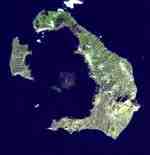
Thera
Santorini, Greece
-
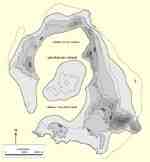
Pre-Eruption Minoan Thera
Santorini, Greece
-

Spring Fresco West Wall
Swallows Scene
Akrotiri, Santorini (Thera), Greece
-
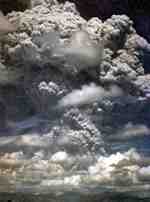
Mt. Pinatubo Eruption
Luzon, Phillipines
1991
-

Minoan Ladies in Blue Fresco
Knossos, Crete, Greece
-

Volcanic Phreatic Eruption
-
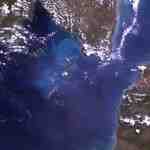
Krakatau
Sunda Strait, Indonesia
-

Minoan Miniature Frieze
Admirals Flotilla Fresco
Shipping Scene Restoration
West House, Room 5, South Wall
Akrotiri, Santorini (Thera), Greece
-

Mt. Pinatubo Eruption
Luzon, Phillipines
1991
-
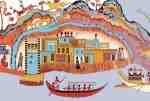
Minoan Miniature Frieze
Admirals Flotilla Fresco
Thera Restoration Scene
West House, Room 5, South Wall
Akrotiri, Santorini (Thera), Greece
-

Minoan Bull Leaping Toreador Restoration Fresco
Knossos, Crete, Greece
-

Volcanic Pyroclastic Surge
Montserat, Caribbean
1996
-

Minoan Dolphins Restoration Fresco
Knossos, Crete, Greece
-

Minoan Sea Daffodils Lilies Restoration Fresco
Akrotiri, Santorini (Thera), Greece
-
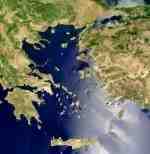
Aegean Sea
-
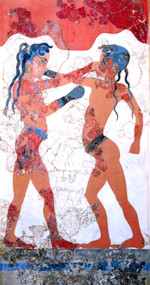
Minoan Boxing Boys Fresco
Akrotiri, Santorini (Thera), Greece
-
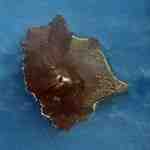
Anak Krakatau
Sunda Strait, Indonesia
-

Minoan Antelope Restoration Fresco
Akrotiri, Santorini (Thera), Greece
-
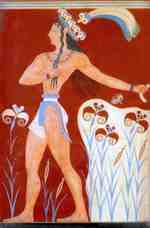
Minoan Priest King
Feathered Prince of Lilies Fresco
Knossos, Crete, Greece
-

Anak Krakatau
Sunda Strait, Indonesia
-
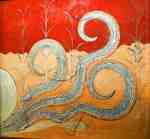
Minoan Octopus Fresco
Knossos, Crete, Greece
-
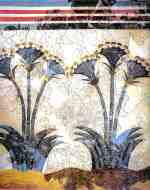
Minoan Sea Daffodils Lilies Fresco
Akrotiri, Santorini (Thera), Greece
-

Minoan Bull Leaping Toreador Fresco
Knossos, Crete, Greece
-

Minoan Antelope Fresco
Akrotiri, Santorini (Thera), Greece
-

Minoan Dolphins Fresco
Knossos, Crete, Greece
-

Knossos Reconstruction
Crete, Greece
-

Knossos Reconstruction
Crete, Greece
-
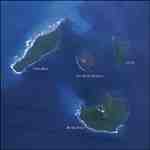
Krakatau
Sunda Strait, Indonesia
-

Krakatau Map
Sunda Strait, Indonesia
-

Volcanic Explosivity Index
VEI Scale
-
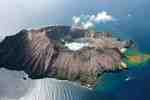
White Island Marine Volcano
New Zealand